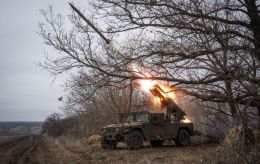Advantages of JSOW aerial bomb: Will Ukraine be able to utilize it fully
 Photo: The US transfers JSOW cruise bombs to Ukraine (illustrative photo navy.mil)
Photo: The US transfers JSOW cruise bombs to Ukraine (illustrative photo navy.mil)
The administration of US President Joe Biden has allocated a record military aid package to Ukraine amounting to $7.9 billion. This decision is historic not only because of the funding amount but also because it marks the first time a new category of weapons—long-range Joint Standoff Weapon (JSOW) munitions—will be provided.
RBC-Ukraine explains what these bombs are and what tasks they can accomplish.
Contents
- US is transferring JSOW cruise bombs: What is known
- What are these bombs and what are their characteristics
- Features of the AGM-154 JSOW considering conditions in Ukraine
- How Ukraine will use JSOW and whether it will employ F-16s
US is transferring JSOW cruise bombs: What is known
The first report on the transfer of JSOW was made by ABC News, citing a source within the Pentagon. The batch of glide bombs has been allocated as part of a $375 million package announced the day before.
These munitions can be launched from F-16 fighter jets. The bombs feature retractable wings that enable targeting at distances over 100 km. There are several versions of JSOW; according to a Pentagon official, Ukraine will receive the variant equipped with cluster munitions.
Today, Biden announced that he has directed the allocation of all remaining security funding planned for the remainder of his presidency. This includes sanctioning $5.5 billion for direct drawdown from stockpiles and $2.4 billion for production. This package will include drones, an additional Patriot system, AMRAAM missiles, and air-to-ground munitions.
“To enhance Ukraine’s long-range strike capabilities, I have decided to provide Ukraine with the Joint Standoff Weapon (JSOW) long-range munition,” states the announcement on the White House website.
Ukrainian President Volodymyr Zelenskyy thanked American partners for the Patriot and other air defense systems, interceptor missiles, long-range missiles, and air-to-ground munitions. He also expressed gratitude for the decision to expand the training program for a greater number of pilots on F-16s.
What are these bombs and what are their characteristics
The AGM-154 Joint Stand-off Weapon (JSOW) is an aerial bomb equipped with wings and aerodynamic surfaces to correct and extend its flight range.
It was developed through collaboration between the US Navy and the US Air Force to standardize precision-guided munitions of medium range, particularly for striking protected targets located beyond standard air defense systems, thereby enhancing the survivability of aircraft.
Testing of the JSOW began in 1995, and it was officially adopted into service in 1999. In addition to the United States, it is also used by Australia, Finland, Greece, Poland, Singapore, and Türkiye.
_Tour_de_Sky_2014-08-10_06_AGM-154.jpg)
Photo: JSOW aerial bomb under the wing of an F-18 (navy.mil)
The baseline version of the AGM-154A was used during the war from 2003 to 2011 in Iraq and during Operation Enduring Freedom in Afghanistan. Overall, US forces employed over 400 units.
There are three variants. The AGM-154A is the basic design. Its warhead consists of 145 BLU-97 submunitions. It is designed to destroy unprotected or lightly armored stationary targets, such as trucks, armored personnel carriers, and aircraft on airfields.
The AGM-154B has a cluster warhead with six BLU-108/B submunitions, each of which releases four projectiles. Infrared sensors are used to detect targets. When the submunition approaches the target, it explodes and forms a cumulative jet capable of destroying armor.
The AGM-154C uses infrared autonomous guidance and carries a 225 kg warhead. It has been designed to strike point targets and has been in service with the US Navy since 2005.
Key Specifications:
- Length: 4.06 m
- Diameter: 33 cm
- Weight: 483 kg
- Wingspan: 2.7 m
- Carriers: F/A-18C/D, F/A-18E/F, F-16, F-15E, F-35A/C, B-1B, B-2A, B-52H, JAS 39 Gripen
- Range: 22 km (low-altitude launch), 130 km (high-altitude launch)
- Warheads: BLU-97/B combined action, BLU-111/B (unitary warhead), BROACH (multi-stage warhead)
The range of 130 km is achieved when released from an altitude of 8 km and at a speed of 960 km/h. The guidance of the baseline AGM-154 is performed by an inertial system with GPS satellite signal correction. Later versions, such as the AGM-154C, feature an infrared homing head.
The F-16 can carry up to four JSOW bombs. Preparation and programming of the munitions are completed before takeoff within a few minutes.
JSOW air-to-ground bombs can generally be described as a response to Russian KABs (guided aerial bombs), according to aviation expert Valerii Romanenko, a leading researcher at the National Aviation University (NAU).
"Although they have a standard caliber, the Russians possess a large number of different KABs. JSOWs are 'smarter' cruise bombs than the Russian ones. However, they are also more complex and very expensive, costing up to $500,000. In comparison to JDAM-ERs (which are already used by Ukrainian aviation), they have a shorter range but are ten times more expensive. Therefore, the feasibility of acquiring such munitions is highly questionable," he told RBC-Ukraine.
Features of the AGM-154 JSOW considering conditions in Ukraine
Analysts from the Ukrainian portal Defense Express also find the transfer of AGM-154 JSOWs to be a strange decision, even though the munitions are integrated for the F-16. The issue is that the maximum range is achieved at high-altitude flight, but Ukrainian aviation is limited in this regard due to Russia's advantage in aircraft and the high density of long-range air defense systems.
For this reason, all Ukrainian glide bombs are deployed from low altitudes, which restricts the range to 22 km. There is also a completely hypothetical scenario of converting the JSOW into a cruise missile. In the mid-2000s, development began on the JSOW-ER, which, with the installation of a rocket engine, could strike targets over 500 km away. However, the project was not fully realized.
"The development of this version is still ongoing. Whether it will be tested in Ukraine is unclear. But we return to the fact that it still won’t reach 500 or 1000 km," aviation expert Anatolii Khrapchynskyi told RBC-Ukraine.

Photo: Launch of JSOW from an F-16 fighter (af.mil)
Certainly, the AGM-154 JSOW has its advantages.
"First of all, they are more resistant to electronic warfare measures, and right now the Russians are trying to jam everything with electronic warfare: JDAM-ERs, HIMARS munitions, and everything else. Secondly, they can have a cluster warhead, which includes munitions that combine cumulative and fragmentary effects. If such a weapon strikes an airfield, the aircraft will be irrecoverable. The cumulative jet can penetrate the aircraft entirely. If it hits the fuel tank in the wing, the aircraft will simply burn," emphasizes Romanenko.
The stealth technology is also a plus, but the advantages largely end there due to the high cost. Sources speaking to RBC-Ukraine agree that under current conditions, the AGM-154 JSOW is not very useful. Due to the large number of Russian air defense systems, the maximum range from which they can be launched is only 22 km. In contrast, JDAM-ERs can easily fly around 40 km.
How Ukraine will use JSOW and whether it will employ F-16s
Ukrainian forces will not be able to address the issue of launching Russian KABs with the help of JSOWs. This is primarily due to the lack of permission for strikes on Russian territory, and even if they manage to strike at 130 km, they cannot reach the main operational airfields.
"We will be able to operate along the front line. But can we launch thousands per month, as Russia does? No, because we won’t be given that many. There are many questions regarding these air-to-ground bombs. However, as soon as we get the 'green light' for strikes on Russian territory, we can talk about a certain expansion of our capabilities," Khrapchynskyi noted.
One of the standard carriers is the F-16 aircraft. The expert emphasizes that a recent assessment of the capabilities of the Mirage-2000 (which Ukraine may also receive) took place, but it is unclear whether these aircraft can launch JSOWs.
The transfer of such munitions does not mean that Ukrainian F-16s will operate on the frontline. "God forbid, why risk such aircraft? We have only five left. Perhaps by the end of the year, there will be ten. But I see no sense in risking them for functions where you can only destroy a maximum of a platoon of infantry," says Valerii Romanenko.
It is possible that Soviet-type aircraft, such as the Su and MiG, will be adapted for the JSOW bombs. In principle, it is not a problem; various Western munitions, including Storm Shadow cruise missiles, can be mounted on Soviet-designed aircraft. However, the effectiveness of using JSOWs on F-16s is likely much higher.
But in no case will this weapon solve Ukraine's strategic tasks.
"We're talking about another weapon that can help deter the Russian advance on Ukrainian territory. However, it cannot affect strategic issues related to strikes on targets in Russia. In reality, we need much longer-range capabilities," Khrapchynskyi said.
According to him, looking at the characteristics, JSOW is a "cool" bomb that can work well along the frontline. However, to work really effectively, it is necessary first to establish order in the airspace, achieve at least parity, which can be done by destroying enemy air defense systems, warehouses, and so on, to clear the skies for F-16s and other aircraft.
**
Experts interviewed by RBC-Ukraine do not consider the Biden administration's decision a significant step forward.
"It’s hard to say that we were heard when instead of JASSM missiles (which have ranges from 370 to nearly 2000 km), we are being given this. In our conditions, the strike depth of JSOW is just over 20 km, and the Americans know this very well," explains Romanenko.
Today, the cruise air bomb has become a key aspect of the Russians' advance on the front and their active pressure through strikes on civilian populations.
"Ukraine does not fight this way. Therefore, I would emphasize that the priority in providing Western assistance should be long-range weapons. By long-range weapons, I mean those that can reach targets at 500 and 1000 km," Khrapchynskyi added.
Sources: materials from ABC News and Defense Express, announcements from the White House website, information from open sources, and comments from aviation experts Valerii Romanenko and Anatolii Khrapchynskyi.

